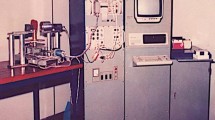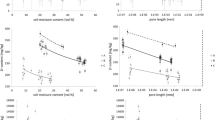Abstract
Lolium perenne growing with high root density on a fine nylon mesh (Kuchenbuch and Jungk, 1982) caused the development of element gradients in the rhizosphere below the mesh. Micro-liter soil solutions from 2-mg soil samples were sprayed onto Formvar-coated grids and analyzed by X-ray microanalysis in a transmission electron microscope. The results were comparable to those obtained by flame photometry and atomic absorption spectrometry (AAS) of conventional soil solutions from 1 g soil. X-ray microanalysis of micro-soil solutions allows the application of different extraction procedures to even small amounts of soil usually available from rhizosphere experiments. Information about soil buffering characteristics in the rhizosphere can thus be obtained. Aluminum accumulation in the rhizosphere of small segments of single Picea abies fine roots grown in undisturbed natural forest soil could be detected with this technique.
Similar content being viewed by others
References
Adams, F 1974 Soil solution. In The Plant Root and its Environment. Ed. E W Carson. University Press of Virginia, Charlottesville.
Classen, N, Hendricks, L and Jungk, A 1981 Erfassung der Mineral-stoffverteilung im wurzelnahen Boden durch Autoradiographie. Z. Pflanzenernaehr. Bodenkd. 144, 306–316.
Clarkson, D T 1991 Root structure and sites of ion uptake. In Plant Roots: The Hidden Half. Eds. Y Waisel, A Eshel and U Kafkafi. pp 417–453. Marcel Dekker, New York.
Cliff, G and Lorimer, G W 1975 The quantitative analysis of thin specimens. J. Microsc. 103, 203–207.
Davies, T W and Morgan, A J 1976 The application of X-ray analysis in the transmission electron analytical microscope (T.E.A.M.) to the quantitative bulk analysis of biological microsamples. J. Microsc. 107, 47–54.
Helal, H M and Sauerbeck, D 1981 Ein Verfahren zur Trennung von Bodenzonen unterschiedlicher Wurzelnähe. Z. Pflanzenernaehr. Bodenkd, 144, 524–527.
Ingram, M J and Hogben, C A M 1967 Electrolyte analysis of biological fluids with the electron microprobe. Anal. Biochem. 18, 54–57.
James, B R, Bartlett, R J and Amadon, J F 1985 A root observation and sampling chamber (rhizotron) for pot studies. Plant and Soil 85, 291–293.
Johnson-Flanagan, A M and Owens, J N 1985 Development of white spruce (Picea glauca) seedling roots. Can. J. Bot. 63, 456–462.
Kuchenbuch, R and Jungk, A 1982 A method for determining concentration profiles at the soil-root interface by thin slicing rhizospheric soil. Plant and Soil 68, 391–394.
Morgan, A J, Davies, T W and Erasmus, D A 1975 Analysis of droplets from iso-atomic solutions as a means of calibrating a transmission analytical electron microscope (TEAM). J. Microsc. 104, 271–280.
Nietfeld H 1993 Modellierung der Ionendymamik in der Rhizosphäre. Diss. Forstlicher Fachbereich, Univ. Göttingen.
Ohno, T 1989 Rhizosphere p H and aluminum chemistry of red oak and honeylocust seedlings. Soil. Biol. Biochem. 21, 657–660.
Riley, D and Barber, S A 1969 Bicarbonate accumulation and pH changes at the soybean (Glycine max. (L.) Merr.) root-soil interface. Soil Sci. Soc. Am. Proc. 33, 905–908.
Roinel, N 1988 Quantitative X-ray analysis of biological fluids: The microdroplet technique. J. Electron Microsc. Tech. 9, 45–56.
Russ, J C 1974. The direct element ratio model for quantitative analysis of thin sections. In Microprobe Analysis as Applied to Cells and Tissues. Eds. T A Hall, P Echlin and R Kaufmann. pp 269–276. Academic Press, London.
Shuman, H, Somlyo, A V and Somlyo, A P 1976 Quantitative electron probe microanalysis of biological thin sections: methods and validity. Ultramicroscopy 1, 317–339.
Smith, W H and Pooley, A S 1989 Red spruce rhizosphere dynamics: spatial distribution of aluminum and zinc in the near-root soil zone. Forest Science 35, 1114–1124.
Tan, K H and Nopamornbodi, O 1979 Electron microbeam scanning of element distribution zones in soil rhizosphere and plant tissue. Soil Sci. 127, 235–241.
Waisel, Y and Eshel, A 1991 Multiform behavior of various constituents of one root system. In Plant Roots: The Hidden Half. Eds. Y Waisel, A Eshel and U Kafkafi. pp 39–52. Marcel Dekker, New York.
Walker, J M and Barber, S A 1961 Ion uptake by living plant roots. Science 133, 881–882.
Zobel, R W 1992 Root morphology and development. J. Plant Nutr. 15, 677–684.
Author information
Authors and Affiliations
Rights and permissions
About this article
Cite this article
Fritz, E., Knoche, D. & Meyer, D. A new approach for rhizosphere research by X-ray microanalysis of microliter soil solutions. Plant Soil 161, 219–223 (1994). https://doi.org/10.1007/BF00046392
Received:
Accepted:
Issue Date:
DOI: https://doi.org/10.1007/BF00046392




